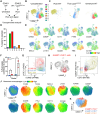This is a preprint.
Tracing LYVE1+ peritoneal fluid macrophages unveils two paths to resident macrophage repopulation with differing reliance on monocytes
- PMID: 40166277
- PMCID: PMC11957119
- DOI: 10.1101/2025.03.19.644175
Tracing LYVE1+ peritoneal fluid macrophages unveils two paths to resident macrophage repopulation with differing reliance on monocytes
Abstract
Mouse resident peritoneal macrophages, called large cavity macrophages (LCM), arise from embryonic progenitors that proliferate as mature, CD73+Gata6+ tissue-specialized macrophages. After injury from irradiation or inflammation, monocytes are thought to replenish CD73+Gata6+ LCMs through a CD73-LYVE1+ LCM intermediate. Here, we show that CD73-LYVE1+ LCMs indeed yield Gata6+CD73+ LCMs through integrin-mediated interactions with mesothelial surfaces. CD73-LYVE1+ LCM repopulation of the peritoneum was reliant upon and quantitatively proportional to recruited monocytes. Unexpectedly, fate mapping indicated that only ~10% of Gata6-dependent LCMs that repopulated the peritoneum after injury depended on the LYVE1+ LCM stage. Further supporting nonoverlapping lifecycles of CD73-LYVE1+ and CD73+Gata6+ LCMs, in mice bearing a paucity of monocytes, Gata6+CD73+ LCMs rebounded after ablative irradiation substantially more efficiently than their presumed LYVE1+ or CD73- LCM upstream precursors. Thus, after inflammatory insult, two temporally parallel pathways, each generating distinct differentiation intermediates with varying dependencies on monocytes, contribute to the replenish hment of Gata6+ resident peritoneal macrophages.
Conflict of interest statement
Competing interests: none
Figures





References
-
- Zindel J. et al., Primordial GATA6 macrophages function as extravascular platelets in sterile injury. Science 371, (2021). - PubMed
-
- Vega-Perez A. et al., Resident macrophage-dependent immune cell scaffolds drive anti-bacterial defense in the peritoneal cavity. Immunity 54, 2578–2594 e2575 (2021). - PubMed
-
- Davies L. C. et al., A quantifiable proliferative burst of tissue macrophages restores homeostatic macrophage populations after acute inflammation. Eur J Immunol 41, 2155–2164 (2011). - PubMed
Publication types
Grants and funding
LinkOut - more resources
Full Text Sources
Research Materials
Miscellaneous
